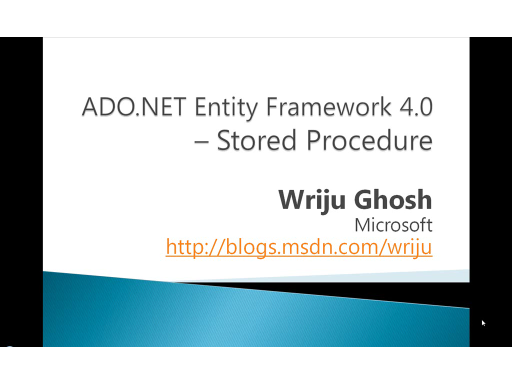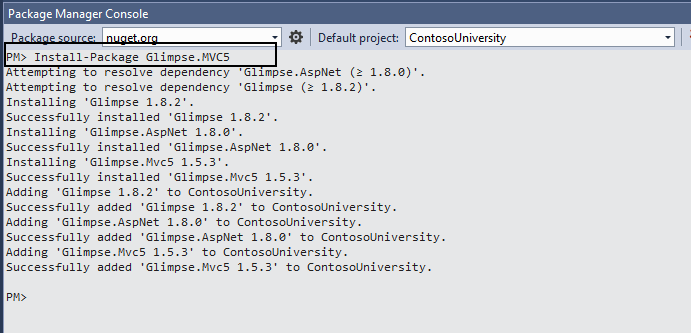Installing Ado Net Entity Framework
ADO.NET Entity Framework Tools. Entity Framework is Microsoft. Add the EntityFramework NuGet package to your project or install the Entity Framework. Jul 22, 2011 ADO.NET Entity Framework provides a strongly-typed LINQ data access experience over relational databases, including direct, efficient access to SQL Server. Oct 23, 2016. Of the Entity Framework Tools for Visual Studio installed. See Get Entity Framework for. ADO.NET Entity Data Model. An existing database.
Getting Started with EF Core on ASP.NET Core with a New database. 4 minutes to read. Contributors. In this article In this walkthrough, you will build an ASP.NET Core MVC application that performs basic data access using Entity Framework Core. You will use migrations to create the database from your EF Core model. See for more Entity Framework Core tutorials.
This tutorial requires:. with these workloads:.
ASP.NET and web development (under Web & Cloud).NET Core cross-platform development (under Other Toolsets).
Updated: October 23, 2016 In previous versions of EF the code was split between core libraries (primarily System.Data.Entity.dll) shipped as part of the.NET Framework and out-of-band (OOB) libraries (primarily EntityFramework.dll) shipped in a NuGet package. EF6 takes the code from the core libraries and incorporates it into the OOB libraries. This was necessary in order to allow EF to be made open source. The consequence of this is that applications will need to be rebuilt against the moved types. This should be straightforward for applications that make use of DbContext as shipped in EF 4.1 and later.
A little more work is required for applications that make use of ObjectContext but it still isn’t hard to do. Here is a checklist of the things you need to do to upgrade an existing application to EF6. If you have any models created with the EF Designer, you will need to update the code generation templates to generate EF6 compatible code. Note: There are currently only EF 6.x DbContext Generator templates available for Visual Studio 2012 and 2013. Delete existing code-generation templates. These files will typically be named.tt and.Context.tt and be nested under your edmx file in Solution Explorer. You can select the templates in Solution Explorer and press the Del key to delete them.
Note: In Web Site projects the templates will not be nested under your edmx file, but listed alongside it in Solution Explorer. Note: In VB.NET projects you will need to enable 'Show All Files' to be able to see the nested template files.
Add the appropriate EF 6.x code generation template. Open your model in the EF Designer, right-click on the design surface and select Add Code Generation Item. If you are using the DbContext API (recommended) then EF 6.x DbContext Generator will be available under the Data tab. Note: If you are using Visual Studio 2012, you will need to install the EF 6 Tools to have this template. See for details. If you are using the ObjectContext API then you will need to select the Online tab and search for EF 6.x EntityObject Generator.
If you applied any customizations to the code generation templates you will need to re-apply them to the updated templates. The namespaces for DbContext and Code First types have not changed. This means for many applications that use EF 4.1 or later you will not need to change anything. Types like ObjectContext that were previously in System.Data.Entity.dll have been moved to new namespaces.
This means you may need to update your using or Import directives to build against EF6. The general rule for namespace changes is that any type in System.Data. is moved to System.Data.Entity.Core. In other words, just insert Entity.Core. After System.Data.

For example:. System.Data.EntityException = System.Data. Entity.Core.EntityException. System.Data.Objects.ObjectContext = System.Data. Entity.Core.Objects.ObjectContext. System.Data.Objects.DataClasses.RelationshipManager = System.Data.
Entity.Core.Objects.DataClasses.RelationshipManager These types are in the Core namespaces because they are not used directly for most DbContext-based applications. Some types that were part of System.Data.Entity.dll are still used commonly and directly for DbContext-based applications and so have not been moved into the Core namespaces. These are:.
See All 33 Rows On Www.nuget.org
System.Data.EntityState = System.Data. Entity.EntityState.

System.Data.Objects.DataClasses.EdmFunctionAttribute = System.Data. Entity.DbFunctionAttribute Note: This class has been renamed; a class with the old name still exists and works, but it now marked as obsolete.
System.Data.Objects.EntityFunctions = System.Data. Entity.DbFunctions Note: This class has been renamed; a class with the old name still exists and works, but it now marked as obsolete.). Spatial classes (e.g. DbGeography, DbGeometry) have moved from System.Data.Spatial = System.Data. Entity.Spatial Note: Some types in the System.Data namespace are in System.Data.dll which is not an EF assembly.

These types have not moved and so their namespaces remain unchanged.